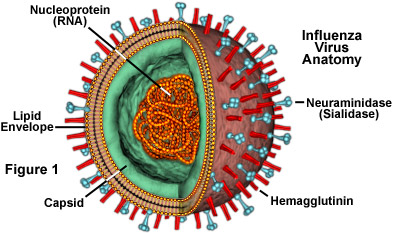 |
| Here is an example of a influenza virus. |
Also known as the "seasonal flu" or flu, influenza is a serious and contagious respiratory illness that's caused by the influenza virus. There are two basic types, A and B, which can cause clinical illness in humans. Influenza A can cause moderate to severe illness in all age groups and infects humans and other animals. Influenza B causes milder disease and affects only humans, primarily children. Each virus particle is basically a protein coat surrounding genetic material known as RNA or ribonucleic acid. Different types of the virus infect different hosts. Symptoms from the virus can range from mild to severe, sometimes leading to pneumonia, bronchitis, and ear infections. Some groups are at a higher risk to influenza than others, including the elderly, young children, and people with certain health conditions.
 |
| This image portrays how vaccinations are derived from chicken eggs. |
As the influenza virus replicates, genetic changes can occur. This transformation can produce new forms of the virus. Some of these forms are so different from the originating virus that they may present a significant risk to a potential host population due to a significant lack of immunity to the new virus. This poses a serious problem for scientists because they have to anticipate what the next alteration will be and try to determine what the next vaccination should be composed of, before this new virus is even discovered. Influenza vaccine typically contains both type A and type B viruses. The viruses selected for the vaccine are grown in chicken eggs. For the inactivated (injectable) vaccine, the viruses are killed with formaldehyde. Live virus vaccine is packaged in a special nasal sprayer.
Now, however, researchers in Japan have announced a breakthrough that may put them one step closer to developing a universal flu vaccine. Such a vaccine would protect against illness from the influenza virus regardless of which strain is actually flourishing during any given flu season. The Japanese researchers looked inside the virus instead of outside it to find proteins that aren't likely to mutate the way those on the outside do. The research team targeted three strains of the influenza virus for their study - the H5N1 bird flu, Hong Kong A, and Soviet Union A strains. Hopefully, if these Japanese scientists are able to elaborate on their study, they might be able to discover a vaccination that would take care of all influenza viruses.
Sources:
http://www.ehow.com/how-does_5381654_influenza-replicate.html
http://www.vaccineinformation.org/flu/qandadis.asp
http://www.flumist.com/flu-symptoms-and-you/?dbsrc=mi-flum-eng-IPick-nnn-unbrned-insemgoog-nnn&WT.srch=1&WT.mc_id=1102&gclid=COff9fvGwqcCFYx_5QodsHRmig
http://www.virology.ws/2009/12/10/influenza-virus-growth-in-eggs/